Most known for developing the Call of Juarez and Dead Island franchises, Techland is back this week to launch a new open world survival horror title for the PC (including Linux and SteamOS), PlayStation 4 and Xbox One.
Dying Light takes place in an expansive urban environment where players navigate using freerunning “parkour” mechanics while scavenge for supplies to craft weapons and defend against the city’s growing infected population.
The game has been built with Chrome Engine 6, which is a proprietary 3D game engine developed by Techland that was first used over 10 years ago in Speedway Grand Prix and Chrome (a science fiction first person shooter).
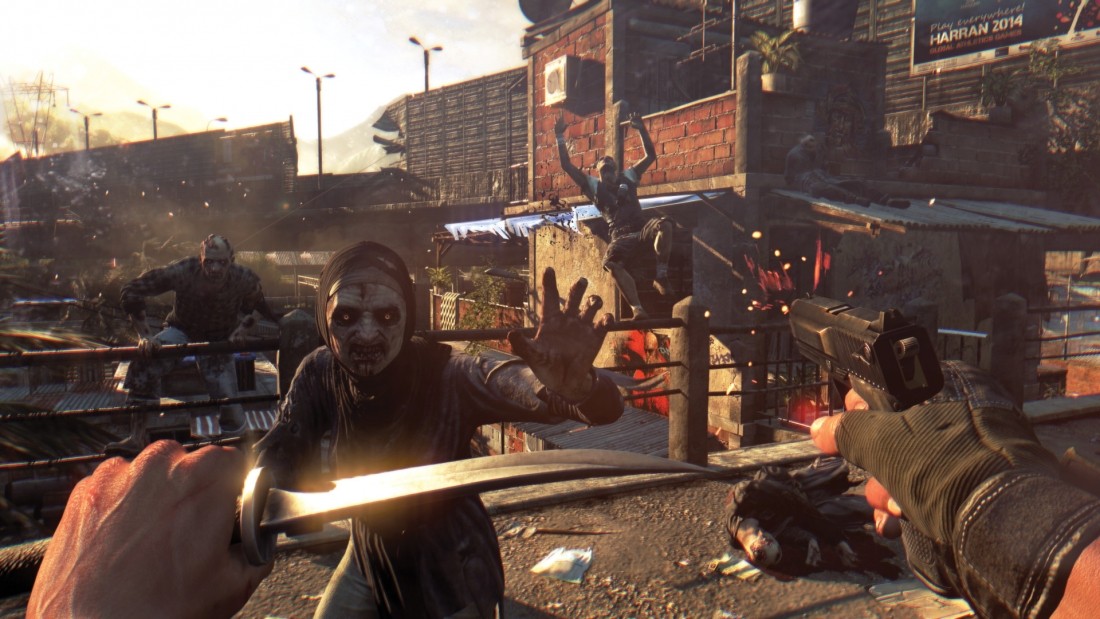
Just as the third version of the game engine spawned Call of Juarez and the fifth version brought Dead Island in 2011, Dying Light is first game to show off Chrome Engine 6 — Hellraid being this year’s only other Chrome 6 title.
Techland says that its latest build of Chrome Engine lets developers create bigger, more detailed open worlds including both indoor and outdoor environments with graphics that are more photo-realistic than ever. Advancements include changeable weather conditions and a physical lighting model with spherical harmonics-based indirect lighting and atmospheric scattering.
Naturally, folks playing on PC an also look forward to a higher texture quality, much further view distances and other graphical improvements such as HBAO+ ambient occlusion and depth of field technology. Perhaps most important of all, consoles have been capped at a sluggish 30fps whereas PC gamers should be able to enjoy well over 60fps with the right hardware.
Testing Methodology
We used the latest AMD and NVIDIA drivers on 28 DirectX 11 graphics card configurations from both companies covering all price ranges. Our test rig was outfitted with the Intel Core i7-5960X to remove CPU bottlenecks that could influence high-end GPU scores.
For benchmarking we used Fraps to record 60 seconds of gameplay. Benchmarking Dying Light is a little tricky as it’s online without checkpoints.
Whenever you quit the game it saves were you currently are and reloads you in that position or the nearest spawn point next time.
This limited how we could test Dying Light and in the end we benchmarked walking around two levels of the building where the game starts. Interestingly, the frame rates are much lower in-doors anyway, so this worked out well.
There are no quality presets in Dying Light so you must set everything up. For testing we maxed out every setting with the exception of NVIDIA HBAO+ to try and keep the results consistent across AMD and NVIDIA cards. That said, we did leave ‘NVIDIA Depth of Field’ enabled.
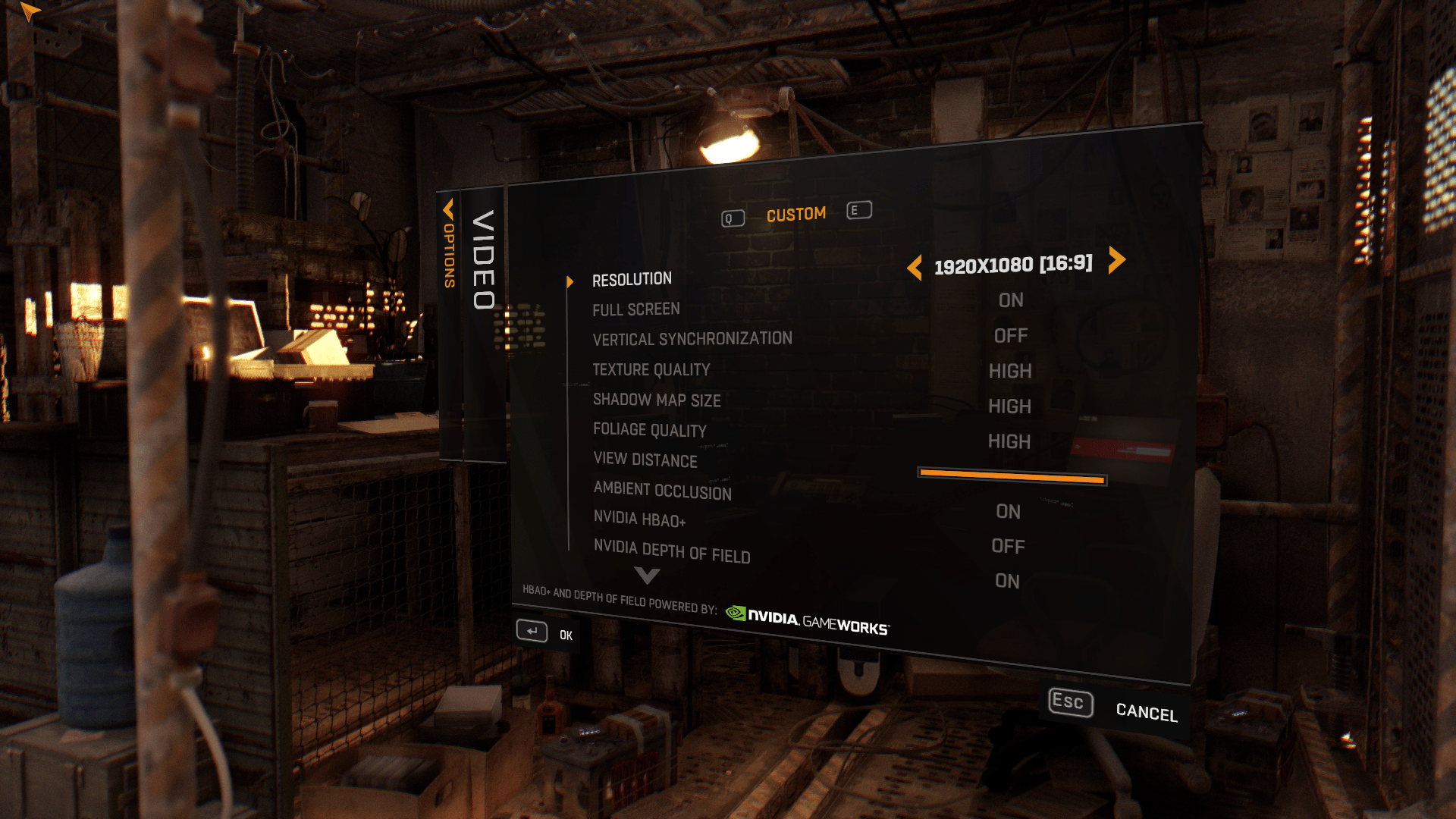
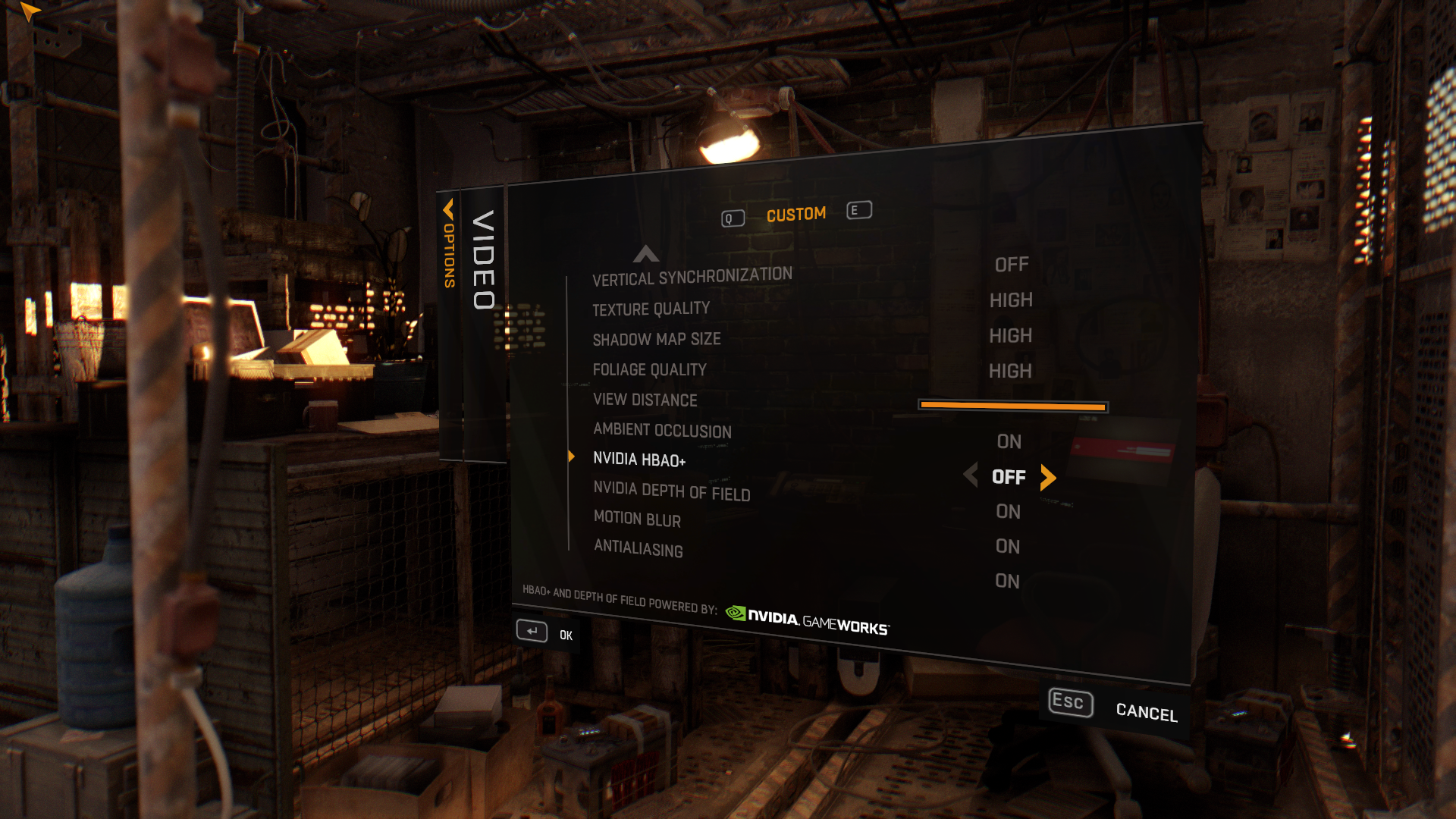
We tested Dying Light using DX11 at three desktop display resolutions: 1366×768, 1920×1080 and 2560×1600.
Post-test notes:
After further investigation we have learned a few things about Dying Light’s performance with the latest v1.2 patch. The performance we found indoors is accurate, however many reviews show performance to be around half what we saw. The issue seemed to be the draw distance, which doesn’t have an impact inside, even when looking out over the landscape as we did.
Our test does include a section where the player walks to the edge of the tower and looks out over the landscape, here the frame rates actually increase significantly which was unexpected.
As it turns out the draw distance isn’t an issue here either as finer details are not displayed. It isn’t until you hit ground level and walk outside that the frame rates take a huge hit with the draw distance set to 100%. Backing the draw distance off to 50 per cent restores performance and gamers will see the numbers we showed in this article.
It is believed that the draw distance performance at 100% can be cured via a patch and if this is the case then the performance we showed inside will be much the same outside as well. For now although we tested with 100 per cent draw distance the results should be treated as though the distance was set to 50 per cent.
Test System Specs
- Intel Core i7-5960X(3.00GHz)
- x4 8GB Crucial DDR3-2133 (CAS 10-10-10-24)
- Asrock X99 Extreme6 (Intel X99)
- Silverstone Strider Series (700w)
- Samsung SSD 850 Pro 512GB (SATA 6Gb/s)
- Gigabyte Radeon R9 290X (4096MB)
- Gigabyte Radeon R9 290 (4096MB)
- Gigabyte Radeon R9 285 (2048MB)
- Gigabyte Radeon R9 280X (3072MB)
- HIS Radeon R9 270X (2048MB)
- HIS Radeon R9 270 (2048MB)
- HIS Radeon R7 265 (2048MB)
- HIS Radeon HD 7970 GHz (3072MB)
- HIS Radeon HD 7970 (3072MB)
- HIS Radeon HD 7950 Boost (3072MB)
- HIS Radeon HD 7950 (3072MB)
- HIS Radeon HD 7870 (2048MB)
- HIS Radeon HD 7850 (2048MB)
- HIS Radeon HD 7750 (1024MB)
- Gigabyte GeForce GTX Titan (6144MB)
- Gigabyte GeForce GTX 980 (4096MB)
- Gigabyte GeForce GTX 970 (4096MB)
- Gigabyte GeForce GTX 960 (2048MB)
- Gigabyte GeForce GTX 780 Ti (3072MB)
- Gigabyte GeForce GTX 780 (3072MB)
- Gigabyte GeForce GTX 770 (2048MB)
- Palit GeForce GTX 760 (2048MB)
- Gigabyte GeForce GTX 750 Ti (2048MB)
- Gainward GeForce GTX 680 (2048MB)
- Gainward GeForce GTX 660 Ti (2048MB)
- Gainward GeForce GTX 660 (2048MB)
- Microsoft Windows 8.1 Pro 64-bit
- Nvidia GeForce 347.25 WHQL
- AMD Catalyst 14.12 Omega
Benchmarks: 1366×768
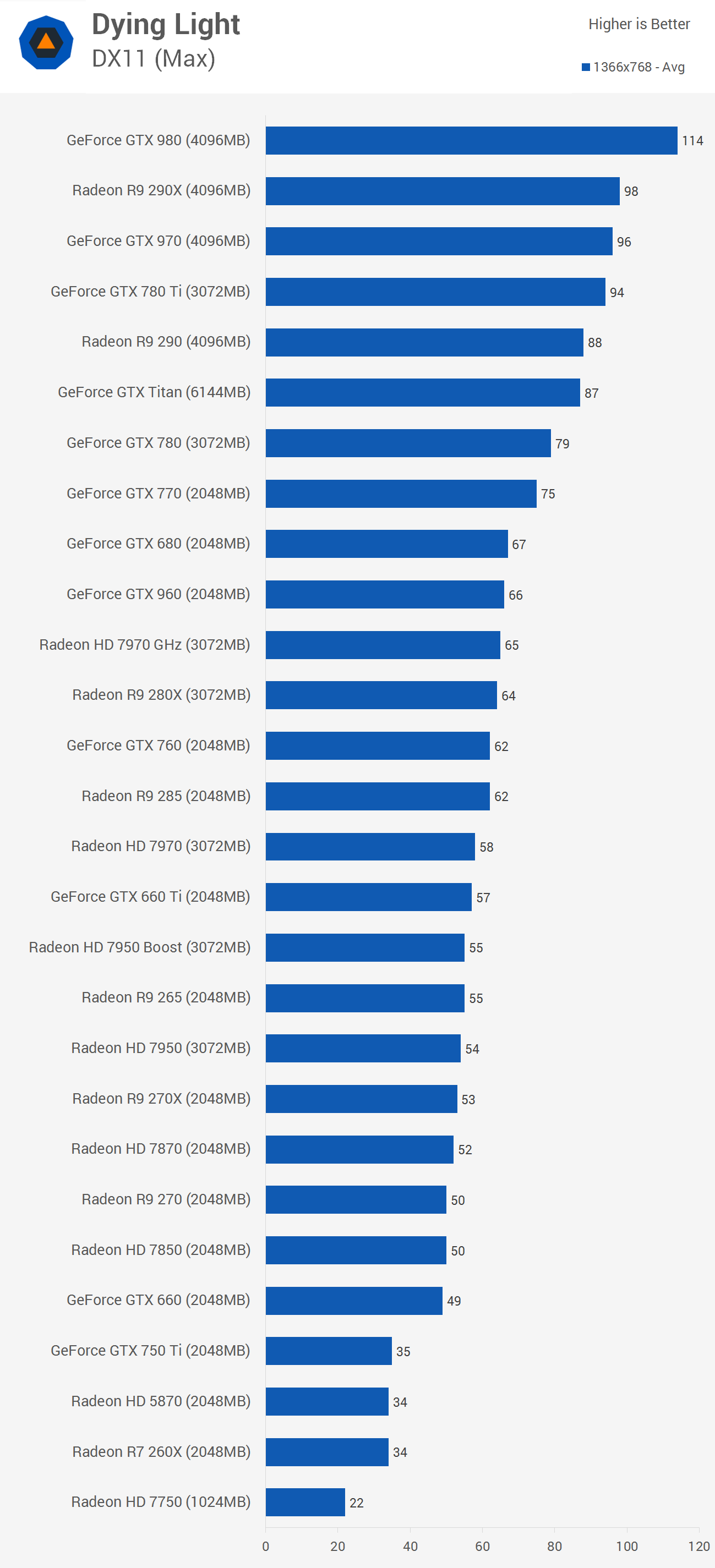
Roughly 27 per cent of all Steam gamers play at 1366×768 and we suspect many (most?) are using a GeForce GTX 660 or something relatively equivalent. Fortunately for that large chunk of the community, the GTX 660 averaged a very playable 49fps, and that is pretty impressive given every setting was maxed besides ambient occlusion, which was disabled.
It’s also possible to achieve an average frame rate of over 30fps with the GTX 750 Ti or R7 260X, though frame rate lag is more noticeable than running at 60fps. Something we found interesting was how the R7 260X matched the performance of the HD 5870 despite being considerably older, the 5870 should be faster.
Benchmarks: 1920×1080
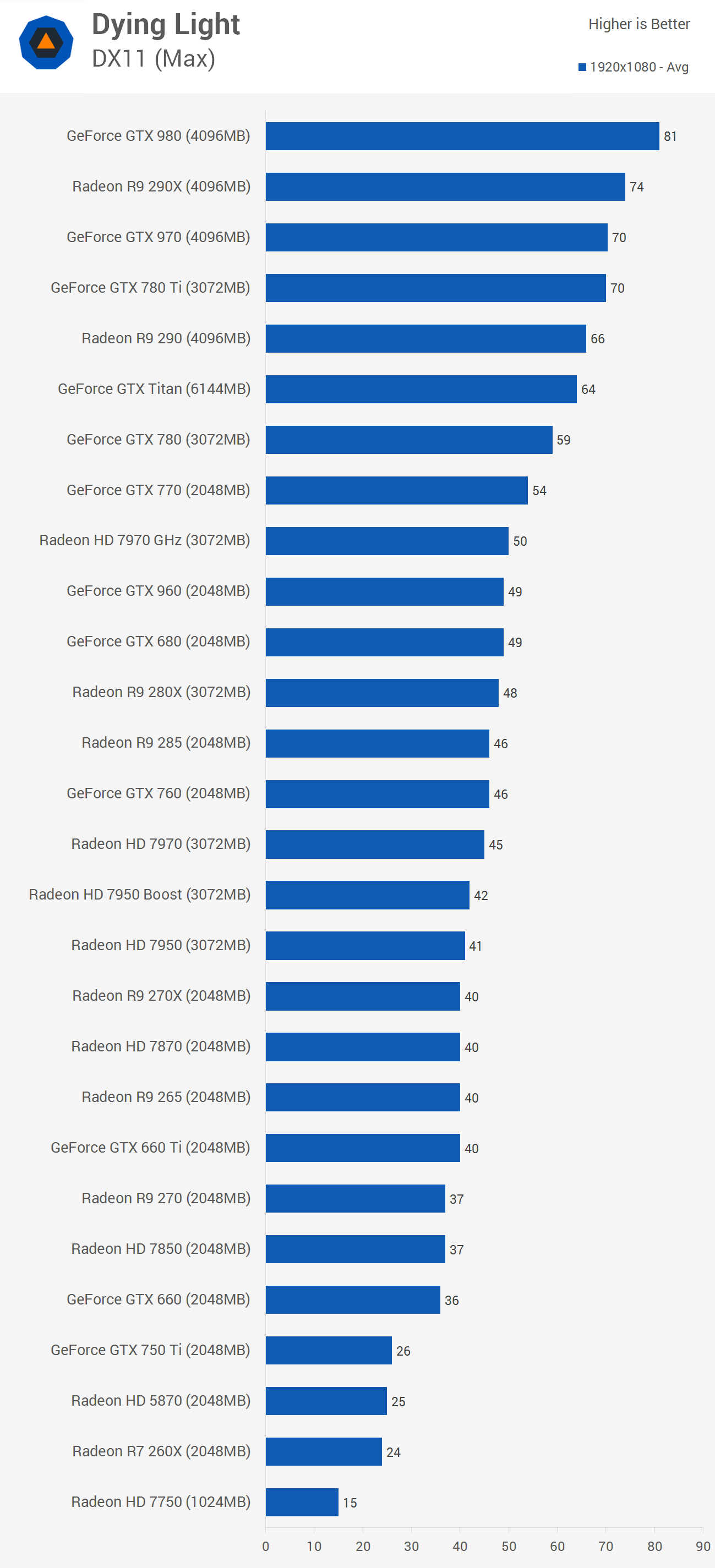
At 1080p the GTX 750 Ti and R7 260X are only able to average 24 — 25fps and that simply isn’t enough for playable performance in Dying Light. The game is extremely choppy with anything less than 40fps — even the in-game menus get difficult to navigate.
Ideally gamers will want to aim for an average of 60fps and for that you need at least a GTX 780 or R9 290. Stll, even at 60fps there is a small amount of occasional lag whereas this wasn’t the case with GPUs that could average over 80fps such as the R9 290X or GTX 970.
Read More:
|
Republished with permission from:

Steven Walton is a writer at TechSpot. TechSpot is a computer technology publication serving PC enthusiasts, gamers and IT pros since 1998.
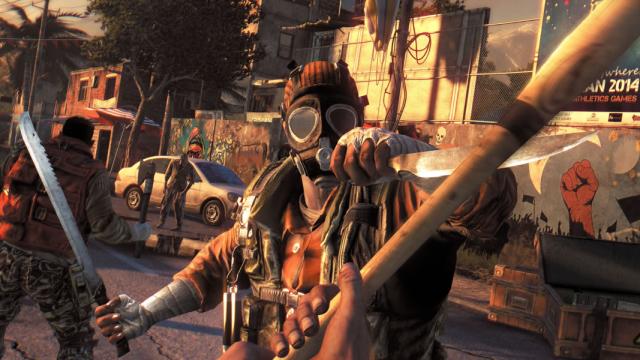
Comments
15 responses to “Dying Light Benchmarked: Graphics And CPU Performance”
And that is at max settings. Nice
Yeah, Im playing everything max but textures on medium, still looks great, with a 660ti 2gb and getting around 60fps. Fucking gorgeous game. When I get a new i7 CPU and mobo in 3 – 4 months, it’ll get cranked up. But, still loving it.
What cpu are you currently using? Just out of curiosity.
Intel(R) Core(TM) i5-2500cpu @ 3.30ghz 3.70ghz
8gb ram
64 bit win 8.1
Nvidia 660ti 2gb card
OS installed to a 128gb SSD and running steam off a 2TB 7200rpm HDD.
Running a 40″ LED tv at 1920×1080 because, you know, movies n stuff. 😛 lol
Must be heavily cpu dependent. My GTX 680 with an i5 2500k is near unplayable unless I turn most things down/off. otherwise no idea why this is happening.
also look on the steam forums for a tool that allows you disable the film grain (disable it for big fps boost and better image quality) and chromatic aberation . it also allowed the ability to disable some shadows but techland for some stupid reason labled it as cheating and block it off with the 1.2.1 patch
techland and or WB have also started issuing DMCA takedown on programs that remove the film grain as well which you guys should check up on
Thank god for my 1366×768 monitor. I was scared I’d have to fork out money for a new graphics card.
My partner’s 1440p however…
ive got an i5 4570 3.2ghz and a GTX 780ti and my settings are all medium to low and i cant get even 50fps stable. this game must be very heavy on the CPU, because im quite sure my gpu can handle 60 pfs on max with this game.
i5 processor and GTX 970, running everything on max, but the view distance is on half, just because that’s how I like it. Runs fine on full.
no sli?
ikr?
For those trying to run this on some older Nvidia cards (im on a 560ti) you will get a MASSIVE performance boost if you install the new drivers and do your optimization through the Nvidia experience rather than the game itself. Dont know why but it does fix the chugging during cinematic.
That’s because nVidia knows the limits of the card you use, the game does not
Sure – but not everyone knows to do that so I thought it was a bit of helpful information.
If anyone is willing to wait until end of Feb then ozgameshop has the pc code for $39.99. You have to wait a month but you save around 30 to 40 dollars. Has anyone seen or got it anywhere else for cheaper?